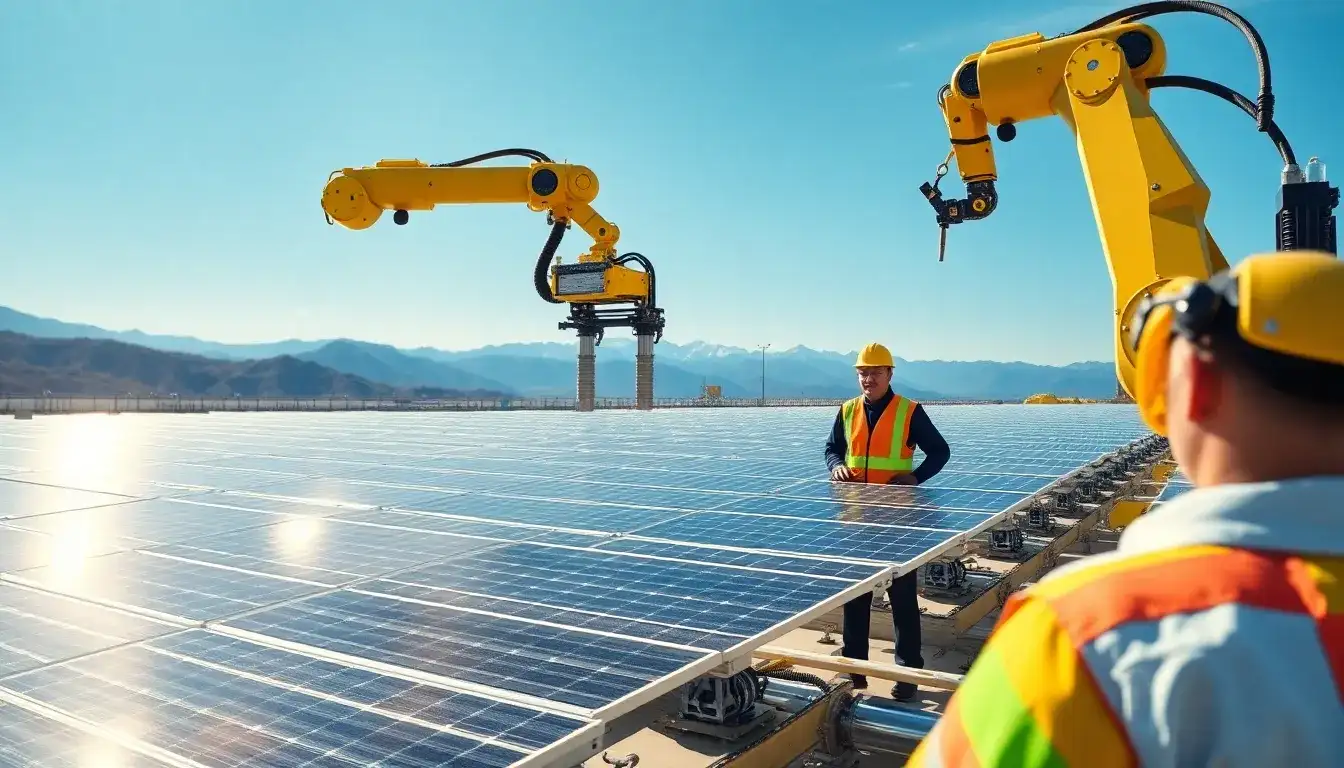
Breakthrough in New Energy at the Two Sessions: China’s Photovoltaic Industry Enters Uncharted Territory with High-Energy Operation and Maintenance Robots!
During the 2025 Two Sessions, the new energy and photovoltaic industries emerged as key topics of discussion. Representatives focused on the deep integration of new energy and technology. Leading enterprises called for strengthened original technology research and development, with Zhong Baoshan, Chairman of Longi Green Energy, emphasizing that China’s photovoltaic industry has entered an “uncharted territory,” where only independent technology can provide solutions.
What does “uncharted territory” mean? It suggests a scenario where even exhaust emissions are undetectable, indicating that China’s energy industry has shifted from mere scale expansion to a critical juncture focused on technological superiority.
A Milestone in Embodied Intelligence and Virtual-Physical Integration
The signals released during the 2025 Two Sessions were clear: the state will establish a growth mechanism for future industrial investments and promote technology implementation through an “AI+” initiative. Notably, the concept of “embodied intelligence” has debuted in the national strategic technology catalog alongside 6G and quantum technology, which the State Council’s research office has described as a “milestone in virtual-physical integration.” In essence, this means that China’s technology will pursue tangible advancements rather than abstract concepts.
This shift indicates that the photovoltaic industry will undergo “smart reconstruction” from a national level. What is embodied intelligence? Its core lies in “physicalized intelligence.” Simply put, it involves equipping AI with sensing and action capabilities, enabling machines to interact with their environment like humans and tackle complex real-world challenges.
As embodied intelligence is elevated to national strategic technology, the question arises: how will it be transformed into a lever for industrial upgrading? The answer is found in the rapidly expanding new energy landscape—by 2025, China’s total installed photovoltaic capacity is expected to exceed 800 GW, with ultra-high voltage transmission lines increasing threefold since 2020. Behind this explosive growth are pressing issues such as the limitations of traditional manual inspections, safety risks leading to work-related injuries, and power generation losses due to dust accumulation on photovoltaic modules. These industry pain points highlight the advantages of embodied intelligence.
Empowering Smart Operation and Maintenance in Photovoltaics
Currently, the latest deployment by the State Grid, the “Tiangong Power Inspection Robot,” is already being utilized for ultra-high voltage operation and maintenance inspections. This robot is equipped with multi-modal sensors and AI models, allowing it to move flexibly in unstructured environments like ultra-high voltage substations and distribution rooms, navigating stairs and narrow passages while accurately locating equipment.
Its coordinated control system enables it to use handheld ultrasonic detectors for partial discharge inspections and perform precise operations such as disconnection and reconnection, significantly enhancing work efficiency and safety in high-risk environments. The implementation of the “Tiangong Power Inspection Robot” has multiplied inspection efficiency and created a digital twin of the power grid through real-time data transmission, supporting hazard warnings and maintenance decisions. Furthermore, the application of embodied intelligence technology is transforming the operation and maintenance model of photovoltaic power plants.
In the realm of drone-assisted inspections and repairs, embodied intelligence can utilize infrared thermal imaging to identify thermal fault hotspots and engage robotic arms to repair damaged photovoltaic modules, addressing the inefficiencies and risks associated with traditional manual inspections. In routine cleaning, embodied intelligence can be equipped with multi-modal sensors (visual, tactile, and dust detection) to dynamically adjust cleaning methods based on the pollution level of solar panels and weather conditions, thereby reducing water waste and extending equipment lifespan.
For intelligent diagnostics and predictive maintenance, embodied intelligence can fully integrate with operation and maintenance systems based on IoT sensing, big data, and AI decision-making capabilities. For example, the self-developed NiOS™ smart operation and maintenance system can collect power generation data with minute-level precision, provide early warnings for faults, manage tasks via cloud-based ticketing, and predict power generation trends and equipment failures. The pain points in photovoltaic operation and maintenance—component contamination, thermal hotspot risks, and power generation fluctuations—are precisely where embodied intelligence and operation systems can collaborate. As technologies like 6G and digital twins develop further, they will promote the new energy sector towards a “zero human intervention” intelligent era.
Private Enterprises Shine: A Dual Empowerment of Technology and Energy
In February, the 2025 National Private Entrepreneurs Conference took place in Beijing. Compared to the similar meeting in 2018, there was a notable shift in participating enterprises, with tech innovation firms like Cloud Deep, Yushu Technology, and Deep Exploration taking the lead. This conference sent a clear signal: China’s leading tech firms are shifting from “market followers” to “technology definers,” simultaneously opening global markets and reinvesting technology into the energy sector.
This represents a “synchronized resonance” between national policy strategies and technology-driven enterprises. As seen with Deep Exploration‘s open-source large models promoting AI accessibility, Yushu Technology‘s robotic dogs entering the global consumer robotics market, and Nenghuanbao applying its self-developed NiOS™ system to commercial photovoltaic power plants, all illustrate the transformation of AI technology into practical market solutions. Currently, giants like Longi and Trina Solar are also beginning to explore a “four-in-one” approach, merging hardware, software, AI, and the internet into super solutions, achieving breakthroughs in the new energy sector.
Looking back at the spring of 2025, what once appeared to be “sci-fi” scenarios—zero-carbon parks, 6G networks, and the industrialization of embodied intelligence—are rapidly materializing. While Western countries grapple with carbon emissions, China’s “green power + AI” strategy is nurturing the next trillion-dollar market. The integration of new energy installation goals with AI technologies is simultaneously driving a significant transformation of the energy system toward intelligence.
In the exploration of this “uncharted territory,” only the footprints of innovators can serve as road markers. China is not just a participant but a leader in the new energy system: pursuing sustainable technological breakthroughs without relying on resource consumption or technological dependencies, allowing Chinese photovoltaic technology to transition from a manufacturing hub to an innovation powerhouse.







